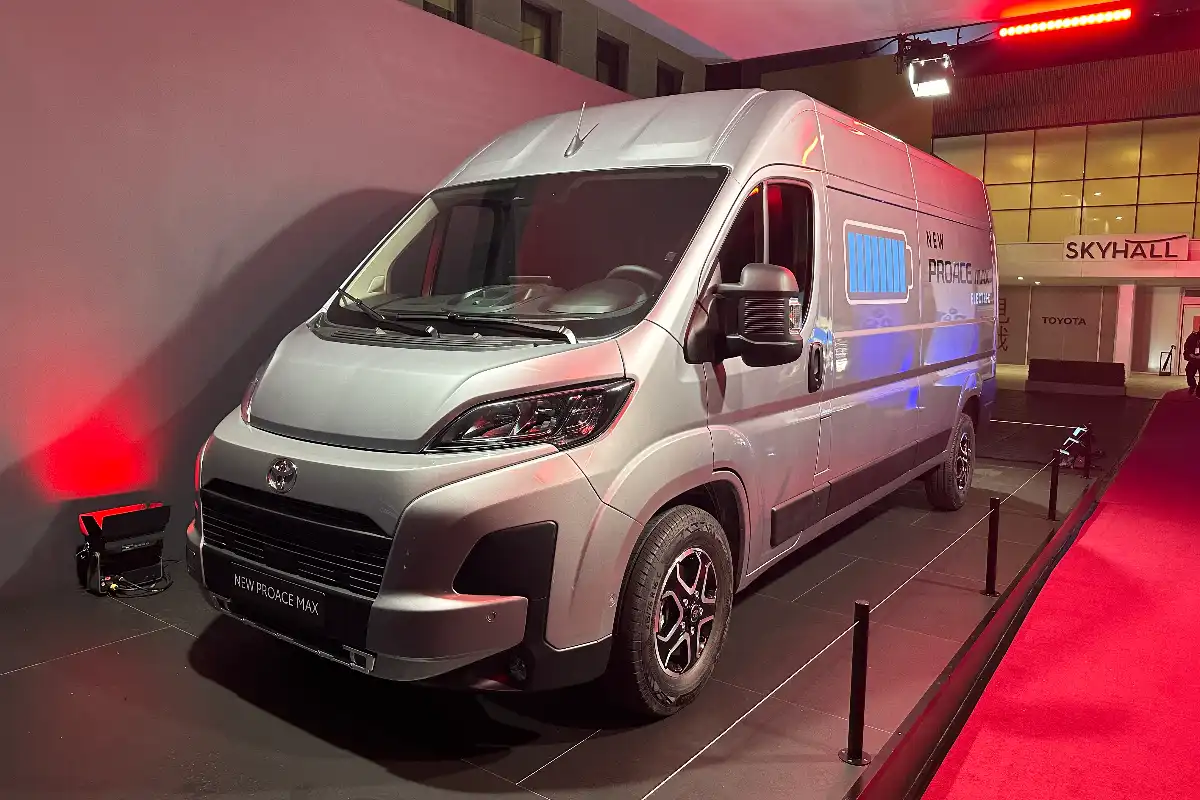Home »

“In a hydrogen future, a hydrogen LCV would perfectly make sense, but the reason that made us convinced that we should go with this [Stellantis] partnership is the scale. We have to reach a very difficult [number of sales] to breakeven or to be profitable in Europe, if you don't reach a 100,000 [unit] threshold. Excluding Hilux, which accounts for roughly 50,000 to 60,000 if you don't partner with somebody that has the possibility to bring the volume at scale it's very difficult to have a profitable business case in Europe. That's why from a Toyota Group perspective, LCV is something important and something we're working on. So far in Europe, to reach a sustainable business model, we have to partner with local competitors.”
A high-performance battery electric powertrain brings the power, comfort, and cost efficiency of EV driving to the new Proace Max.
An effortless drive with the smooth, comfortable ride typical of an EV is achieved thanks to 268bhp/272 DIN hp/200 kW of power combined with the confidence a maximum 410Nm of torque, helping the van take the toughest jobs in its stride.
With a driving range of up to 261 miles (WTLP standard), the fully electric Proace Max has enough range for practical day-to-day operations. Three driving modes allow the driver to adjust acceleration and top speed via Eco, Normal and Power pre-sets to achieve the right balance between performance and driving range for the tasks in hand.
When the high-performance 110kWh battery requires more energy, it can be recharged to 80 per cent in as little as 55 minutes via a fast-charging system of up to 150kW, helping minimise downtime on long journeys. An 11kW AC onboard charger is provided for convenient charging using business or home systems.
In 2023, Toyota reached a new record of more than 140,000 units for its LCV range but has ambitions to exceed 180,000 sales by 2025. That means a market share of 7% and a position in the top six players in the market. To achieve this, Toyota will have to take market share from its partners. To do this, it plans to offer a more focused LCV service, with dedicated sites for certain countries like Poland where market share is high. The addition of the Proace Max will now also enable it to pitch for fleet tenders previously unavailable, as they are now capable of providing a full range.
“We have been growing fast over the last year, so it's not just an ambition. It’s the result of growing – our LCV market share has been growing in all the markets. The LCV offer of the past was made of Hiace and Hilux, since we introduced Proace and Proace City, we started to have a more compelling and complete LCV offer. We are building Toyota Professional dedicated outlets, outside of the main commercial zones. We will go more towards industrial zones to make sure they are convenient for customers, with parking and so on. We can be more competitive, cheaper, and offer more convenience,” Gambart says.
Growth is forecast to come from across the whole of Europe, but Gambart believes some countries will be more successful than others. Those that already have a strong affinity for Toyota LCVs will also be the ones to get the dedicated LCV centres. “Faster traction will be in all the markets where Toyota has already a strong market share. As an example, in Toyota Central Europe, where our passenger car market share is already in a range of 18%, we are targeting above 20% market share in LCV markets. The secondary region where we observe the same is in the Nordics market. Historically the passenger car market is above 10%, but as an example in Norway it’s above 20% market share. These are two solid foundations. Now, the challenge comes more from the Western countries of France, Italy, Spain, UK and Germany.”
Toyota already has 57 dealers covering LCVs in the UK, but despite a growing presence and several impressive fleet deals, the UK is unlikely to be one of the countries to get a roll out of dedicated LCV centres. As for hydrogen, despite trails in the UK, it will invariably depend upon infrastructure, but sale will only come if Toyota and its rivals, including Renault and Stellantis ProOne, can create an offering as compelling as their current full range of diesel and EVs.
Toyota has already tried hydrogen in passenger cars with the Mirai, and after a decade of trying to find a place for it – the first generation Mirai was introduced in 2014 and the most recent model which the Hilux uses was launched in 2021 – it’s finally pulled the plug. Hardly surprising given that at the end of 2023 just 40 countries had hydrogen filling stations and only South Korea (174) and metropolitan areas of Japan (166) could be considered to have anything close to a comprehensive and useable network. Resistance is coming from all angles, with a lack of infrastructure, consumer apathy and even resistance from other OEMs. During the course of speaking with Didier Gambart he said an interesting thing: “If you listen to most of the market and to the customer there is zero interest for hydrogen. If we provide even more cheaper diesel, it [people] will be happy to keep driving diesel LCVs for the next decade”. I don’t think he’s wrong, and diesel will certainly play a very important part over the next decade, but it’s the issue of pricing that really struck a chord. Hydrogen isn’t cheap to make – even if it’s green hydrogen from renewables – and due to its mass consumption diesel remains a cost-effective fuel. One of these factors will have to change. We make hydrogen even cheaper or we tax diesel out of existence. Without that, in the next decade Toyota may well be giving up on hydrogen LCVs as well.